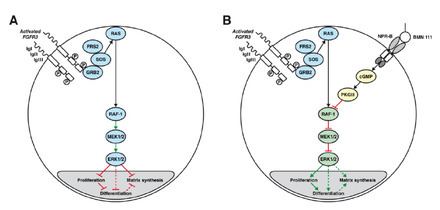Routes of
administration Subcutaneous injection Legal status Investigational CAS Number 1480724-61-5 ChemSpider ID 44210446 | ATC code none Synonyms BMN-111 UNII 7SE5582Q2P | |
 | ||
Vosoritide (INN, codenamed BMN-111) is an experimental drug for the treatment of achondroplasia, the most common cause of dwarfism. It is being developed by BioMarin Pharmaceutical and, being the only available causal treatment for this condition, has orphan drug status in the US as well as Europe. As of September 2015, it is in Phase II clinical trials.
Contents
Mechanism of action
Fibroblast growth factor receptor 3 (FGFR3) is a receptor that normally down-regulates cartilage and bone growth when activated by one of the proteins known as acidic and basic fibroblast growth factor. It does so by inhibiting the development (cell proliferation and differentiation) of chondrocytes, the cells that produce and maintain the cartilaginous matrix which is also necessary for bone growth. Children with achondroplasia have one of several possible FGFR3 mutations resulting in constitutional (permanent) activity of this receptor, resulting in overall reduced chondrocyte activity and thus bone growth.
The protein C-type natriuretic peptide (CNP), naturally found in humans, reduces the effects of over-active FGFR3. Vosoritide is a CNP analogue with the same effect but prolonged half-life, allowing for once-daily administration.
Chemistry
Vosoritide is an analogue of CNP. It is a peptide consisting of the amino acids proline and glycine plus the 37 C-terminal amino acids from natural human CNP. The complete peptide sequence is
PGQEHPNARK YKGANKKGLS KGCFGLKLDR IGSMSGLGCwith a disulfide bridge between positions 23 and 39 (underlined). It has to be applied by injection because it would be digested in the gut when taken orally.
Research
Vosoritide has resulted in increased growth in a clinical trial with 26 children. The ten children receiving the highest dose grew 6.1 centimetres (2.4 in) in six months, compared to 4.0 centimetres (1.6 in) in the six months before the treatment (p=0.01). The body proportions, more specifically the ratio of leg length to upper body length – which is lower in achondroplasia patients than in the average population – was not improved by vosoritide, but not worsened either.
As of September 2015, it is not known whether the effect of the drug will last long enough to result in normal body heights, or whether it will reduce the occurrence of achondroplasia associated problems such as ear infections, sleep apnea or hydrocephalus. This, together with the safety of higher doses, is to be determined in further studies.
Side effects
The drug was tolerated well in this study. Side effects were generally mild and included reactions at the injection site, headache, low blood pressure, back pain, and cough. One incidence of dizziness, possibly related to low blood pressure, was reported; the other cases of low pressure passed without symptoms or treatment.
Society and culture
Some people with achondroplasia, as well as parents of children with this condition, have reacted to vosoritide's study results by saying that dwarfism isn't a disease and consequently does not need treatment.
